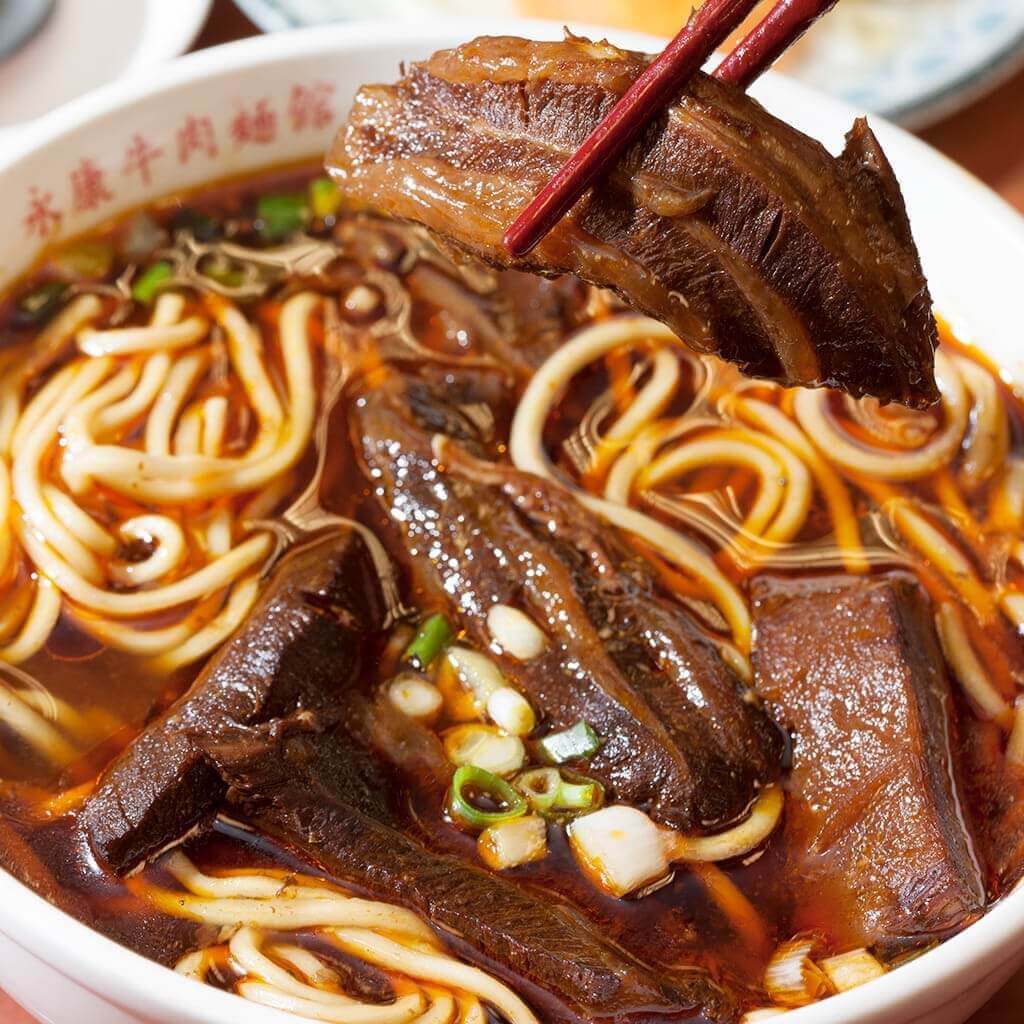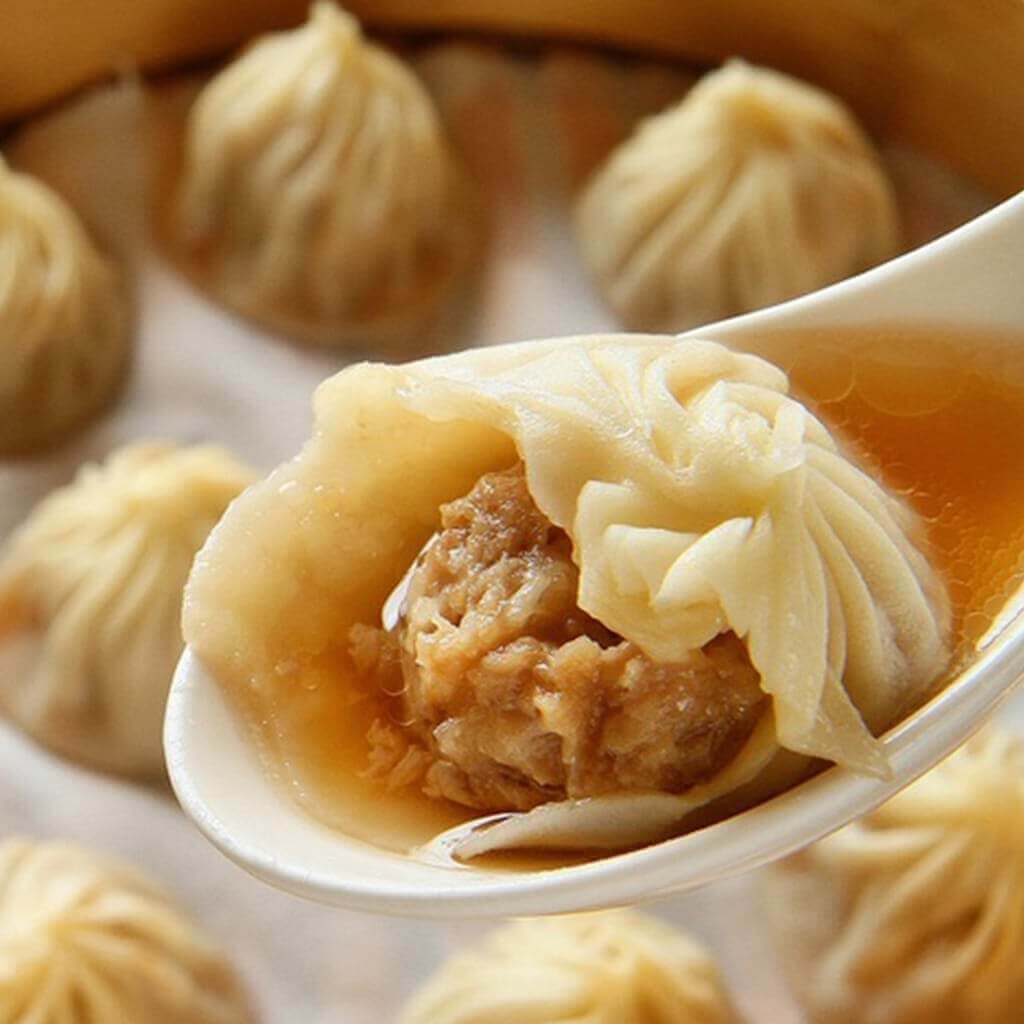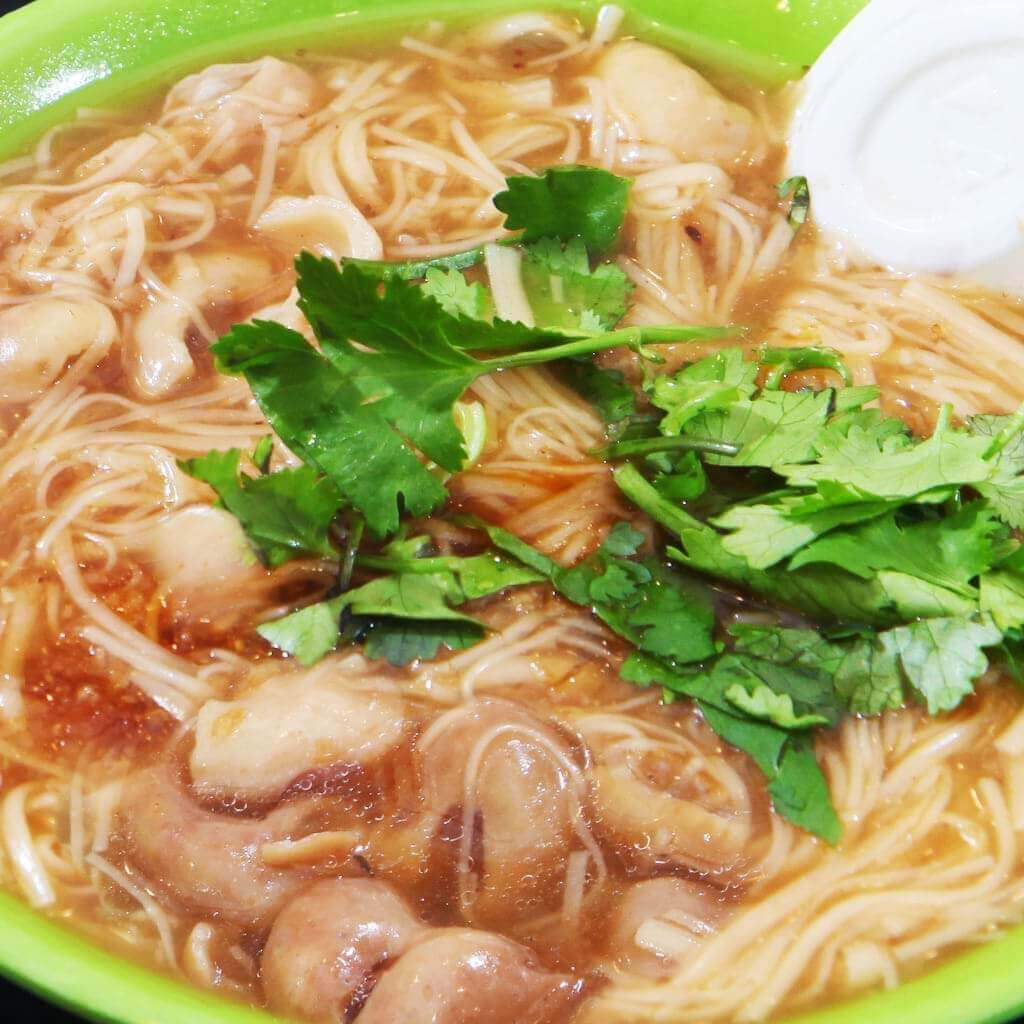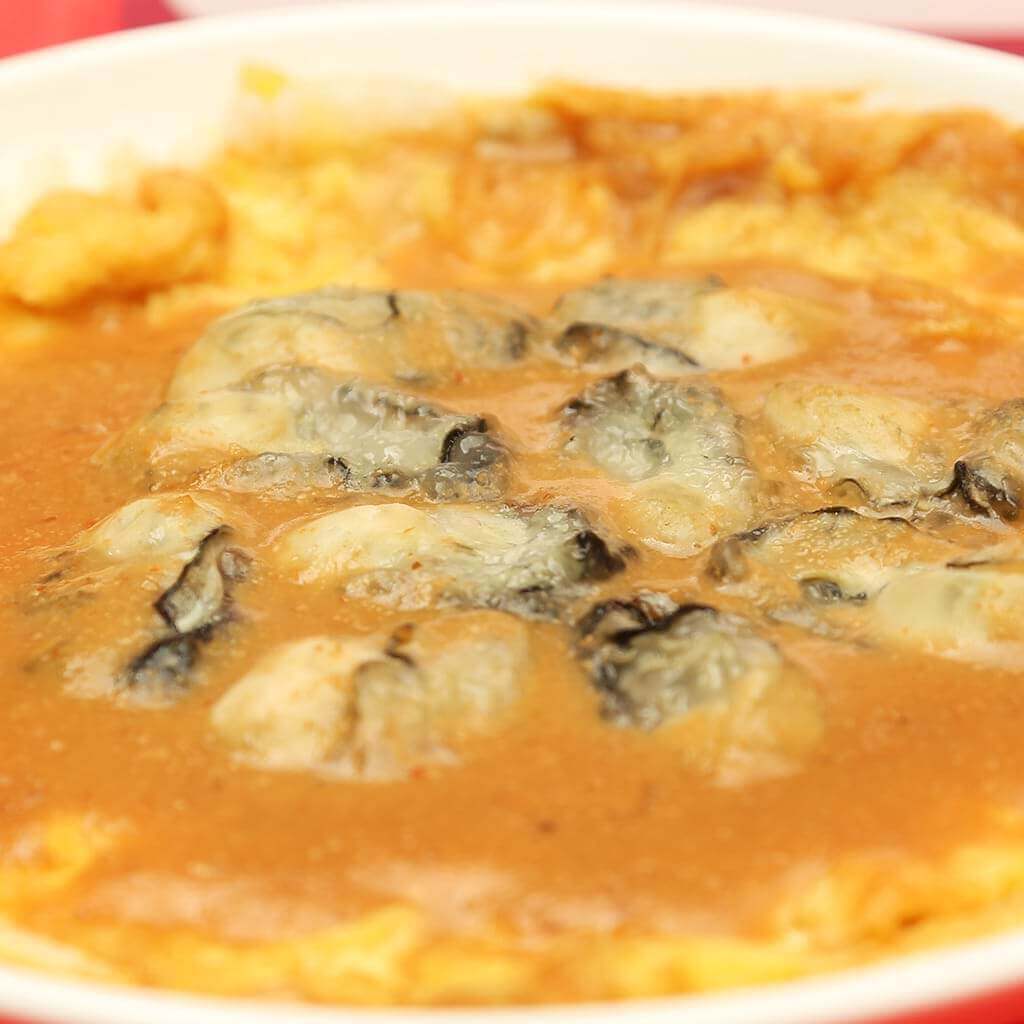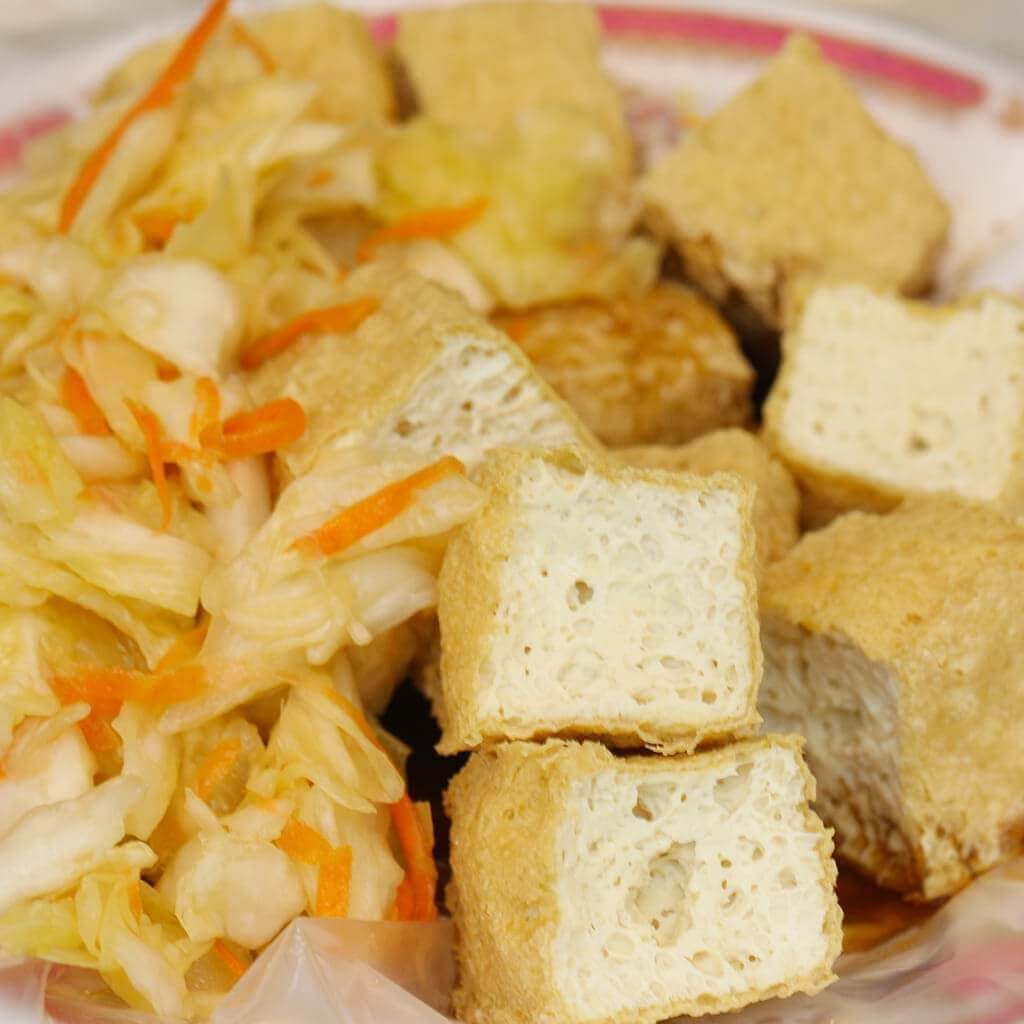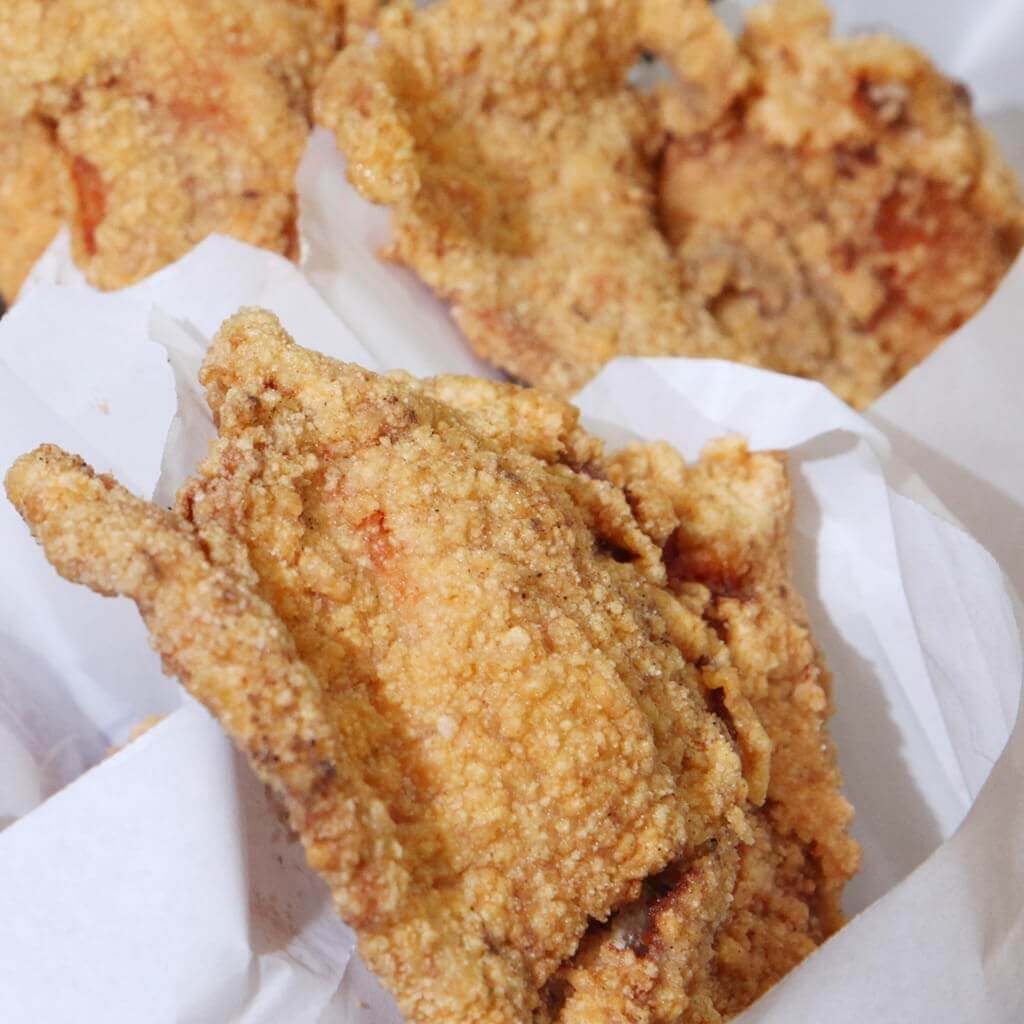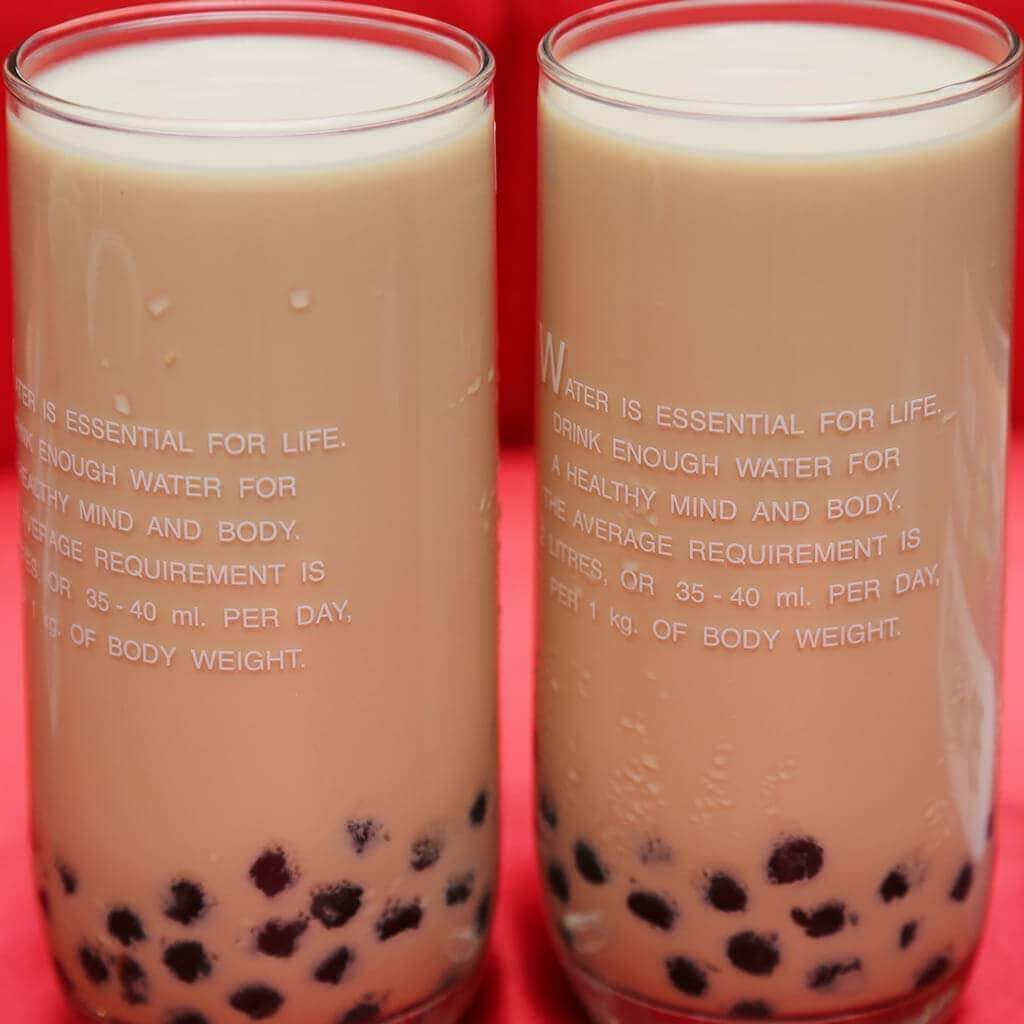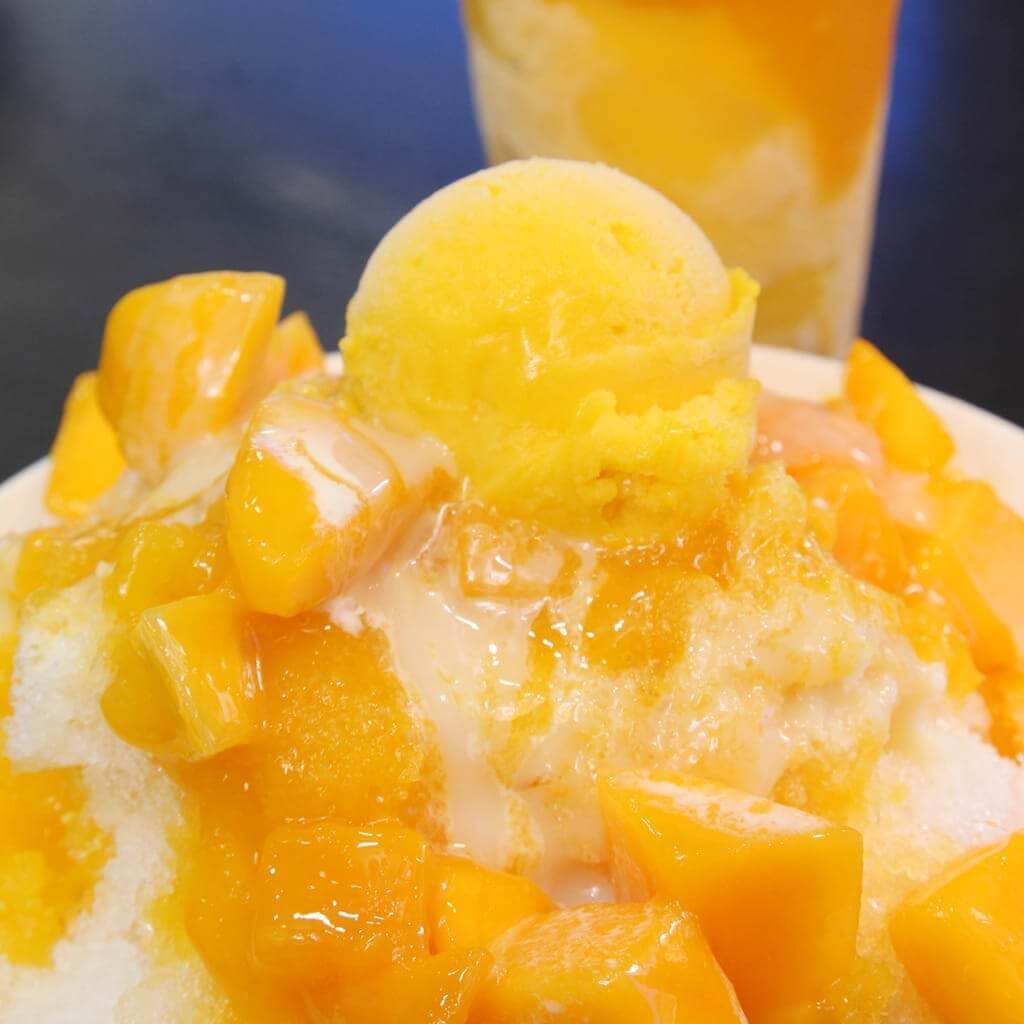- 1
Beef Noodles
Beef noodles are one of the most liked common cuisines in Taiwan. Delicious beef noodles require three essential elements which are noodles, broth and beef. The broth is especially crucial because it is the soul of beef noodles. There are two kinds of beef noodles, braised and clear stewed that come with stewed sirloin and cow tendon. Street vendors and old shops alike endeavor to cook the best beef noodles of the finest taste, and beef noodles have become the pride of Taiwan. - 2
Soup Dumplings
The famous snack originated from the south of Changjiang. It features small size, a considerable amount of fillings, juicy and fresh taste, thin wrapper and exquisite shape. Soup is the soul of traditional soup dumplings. In pursuant of paper-thin wrappers and nice presentation, chefs spread flour on the rolling pin before rolling the dough. Traditional soup dumplings have at least 14 folds each, but in some stores that are particularly dainty about soup dumplings like Din Tai Fung, a soup dumpling might have over 18 folds. - 3
Minced Pork Rice (Stewed Pork Rice)
A bowl of regular-looking minced pork rice will surprise your tastebuds with the tenderness of the pork without greasiness. You can find minced pork rice everywhere from a street vendor to a five-star hotel. It was even once featured in a state banquet. Gastronome Shu Guo-Zhi, the “founder of Taiwanese snacks”, once commented that minced pork rice is the “national rice” of Taiwan. Stewed pork rice commonly refers to the minced pork rice served in Northern and Central Taiwan of which the pork is minced by a knife and stewed with soy sauce. In Southern Taiwan, the pork is minced by machine and the dish is called minced pork rice in direct translation from Chinese. Whereas, stewed pork rice in the South refers to rice that comes with stewed pork bellies which are called soy-stewed pork with rice in Northern and Central Taiwan. - 4
Intestine and Oyster Vermicelli
Vermicelli is a common Taiwanese food. Other than birthday vermicelli, pork knuckle vermicelli and sesame oil vermicelli, intestine and oyster vermicelli using red vermicelli is probably the most renowned Taiwanese dish. The main ingredients of the dish are oysters and vermicelli. Oysters are coated with cornstarch. Sometimes stewed intestines are used as well. Whether a dish of oyster vermicelli is successful depends on the freshness and size of the oysters. The stewing process of the intestines and the ratio over vermicelli are crucial, too. When enjoying a nice bowl of the intestine and oyster vermicelli, you can add some of the store’s signature chili sauce, black vinegar, minced garlic and coriander to elevate the flavor! - 5
Oyster Omelet
A perfectly cooked oyster omelet has a crispy texture from the coating made of yam flour and cornstarch. Each store boasts its signature chili sauce that adds to the smooth and chewy mouthfeel of oyster omelets. The rich scent of eggs explodes in your mouth as you first take a bite of the omelet with refreshing vegetables including garland chrysanthemum and bok choy. Then, as you chew on the star of this dish, the fat, moist and fresh oysters, the crisp sweetness and naturally savory taste of the sea pervade your mouth. It is a must-eat snack when you visit the night market! - 6
Stinky Tofu
Stinky tofu was named after the special aroma of fermented tofu. Whether it is deep-fried or steamed and stewed, that indescribable flavor is what makes it an iconic local snack. Most stinky tofu vendors in Taiwan offer deep-fried ones with non-spicy Taiwanese kimchi or Sichuan kimchi as a side dish to balance off the greasiness of the tofu. Spicy stinky tofu is a new way of enjoying fermented tofu in recent years. It comes with duck blood curd and pickled cabbage in a thick spicy broth immersed in the unique stinky tofu aroma. Some vendors add intestines to the dish known as “intestine stinky hotpot”. - 7
Chicken Cutlet
Chicken cutlet has earned a special status among all Taiwanese snacks with its reputation as the “evilest national food that is most-liked”. Variety in flavors ranges from chili pepper to various seasonings like five-spice, seaweed, and wasabi. There are even variants like barbecued chicken cutlet with sweet sauce and Japanese-style cheese chicken cutlet with cheese fillings. The cooking method varies from the traditional deep-fried version to charcoal-grilled or cheese casserole. There are also vendors that feature gigantic chicken cutlets or chicken thigh cutlets. Speaking as a whole, chicken cutlets are portable and absolutely fulfilling. They are probably the most common street food in Taiwan. - 8
Bubble Tea (Pearl Milk Tea)
Speaking of chicken cutlets, we must not forget about bubble tea. Chicken cutlet and bubble tea make a classic snack combo. Not only does bubble tea looks awesome with different layers, but the chewy tapioca balls (pearls) immersed in the mellow milk tea are also the spirit of the drink that takes you on a journey of revolutionary tastes. The texture of bubble tea is so special that it is extremely well received and has become the most iconic drink of Taiwan. What’s more, bubble tea has even become popular in East Asia, Europe, the United States, and the Middle East! - 9
Shaved Ice
The shaved ice was first introduced to Taiwan during the Japanese colonial period. It is made with an ice-shaving machine and added with different toppings and sauce. It has since become a very common threat in Taiwan. The hot-selling mango shaved ice was selected by CNN and a travel magazine as one of the world’s finest desserts. Top choices include a bowl of mango shaved ice-rich in Taiwanese flavor, taro shaved ice and red bean shaved ice that is most mesmerizing in the mind of many Taiwanese adults and the sweet, retrospective brown sugar shaved ice! - 10
Pineapple Cake
Pineapple cake is a renowned Taiwanese snack made of flour, butter, sugar, eggs, Chinese squash, and pineapple jam. The tender fillings inside the shortcrust coating are full of local flavors that are simple yet authentic. The Taiwanese pronunciation of pineapple sounds like “ong lai” which signifies auspiciousness and prosperity. It is also one of the most popular souvenirs in the minds of foreign tourists in Taiwan.
Tuesday, 24 March 2020
Top 10 most favored Taiwanese dishes!
Thursday, 19 March 2020
11 Best Thai Vegetarian Recipes | Easy Thai Vegetarian Recipes
Thai Vegetarian Recipes: Find here list of 10 best Thai Vegetarian Recipes like Thai pomelo salad, vegetable Thai red curry, Pad Thai, hot yellow curry & many more with key ingredients and how to make process.
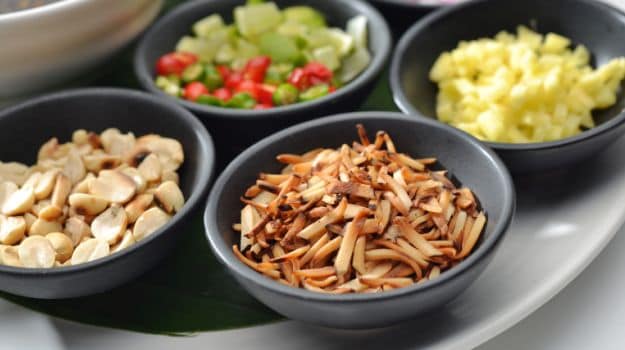
Thai food ain't about simplicity. It's about the juggling of disparate elements to create a harmonious finish. Like a complex musical chord it's got to have a smooth surface but it doesn't matter what's happening underneath. Simplicity isn't the dictum here, at all." -- David Thompson, author of the award-winning cookbook, Thai Food
One of the things that makes Thai food so sensational and favourite with almost everyone who tries it for the first time is its spell-binding aroma and a mix of flavours that are usually so dissimilar yet create a delicious harmony on our palate.
Ever wonder what makes Thai cuisine so special? It's the meticulous and measured play of herbs and spices that makes it truly exquisite. From lemongrass, Thai holy basil, shrimp paste, kaffir lime, to galangal, coconut milk, fish sauce and a host of local condiments that cook up a traditional Thai delicacy. One of the best things about Thai cuisine is the flexibility it offers in its preparations, for instance, you have the fiery red meat curry which can easily be transformed into a vegetarian version without compromising much on the authentic taste.
One of the things that makes Thai food so sensational and favourite with almost everyone who tries it for the first time is its spell-binding aroma and a mix of flavours that are usually so dissimilar yet create a delicious harmony on our palate.
Ever wonder what makes Thai cuisine so special? It's the meticulous and measured play of herbs and spices that makes it truly exquisite. From lemongrass, Thai holy basil, shrimp paste, kaffir lime, to galangal, coconut milk, fish sauce and a host of local condiments that cook up a traditional Thai delicacy. One of the best things about Thai cuisine is the flexibility it offers in its preparations, for instance, you have the fiery red meat curry which can easily be transformed into a vegetarian version without compromising much on the authentic taste.

Thai food borrows heavily from China, Cambodia, Vietnam, Malaysia, Laos, Burma, France, Portugal and other neighbouring countries including India. The Portuguese would take away the credit to introduce chillies to Thailand whereas noodles and steel wok were brought in by the Chinese.
There is a lot of stewing, marinating, baking and grilling that goes into Thai cuisine. The culinary methods of frying, stir frying and deep-frying were introduced by the Chinese. One of the most interesting techniques widely followed in Thai cooking is the pounding or coarsely bruising of herbs instead of chopping them. This ensures all essential oil to seep into the preparation infusing the meal with fresh aroma of herbs.
People of Thailand aren't huge fans of big cuts of meats in their food; hence minced and shredded form of meat is highly popular in Thailand. Naem, minced pork sausage is a local hit in north Thailand- something you must not miss out on, when in Thailand.
What's in Store for a Vegetarian?
In Thailand you will find restaurants that serve pure vegetarian Thai food; these can easily be identified by their yellow banner with a Thai inscription on it in red. Thai vegetarian food uses a lot fruits like jackfruit, papaya, mangosteen, Burmese grapes, rose apples, and durian. The vegetables used are the same that go into making the regular Thai fair including bamboo shoots, lotus stems, Chinese cabbage, straw mushrooms, shiitake, eggplant, etc. Thai curry pastes, galangal, lemongrass, balsam leaves and a host of spices like phrik nu chillies, blend in perfectly to create zingy curries, aromatic broths, fresh salads and crispy stir fries.
Much to your surprise, most Thai food is healthy and low on calorie as it is largely stewed, stir fried or grilled. It is a delighting experience to be able to taste a wonderful blend of meats, veggies, herbs and spices - that is what Siamese cuisine stands for which closely translates into Thai food. Laced with fragrant herbs and mouthwatering spices, either way, Thai cuisine is set to delight you.
We set out to design a garden fresh Thai platter just to suit a regular vegetarian's preferences. These steaming, simmering hot veggie delights will amaze even those who take great pride in relishing non-vegetarian food and cooking with meats. Don't trust us? Try out our best recipes to explore vegetarian Thai food like never before. Cook and relish to the utmost satisfaction!
1. Green Papaya Salad
On a weight loss diet or not, this delicious salad should be on your foodie check-list right now. The freshness of papaya tossed with subtle spices, herbs, lime juice and soy sauce. Take a plunge!
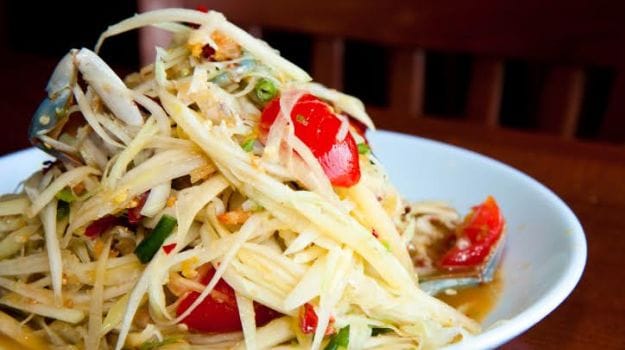
he freshness of papaya tossed with subtle spices and herbs
2. Corn Cakes with Sweet Chilli Sauce
Gorge on these beautiful corn cakes deep fried to golden brown, bathed in authentic Thai flavours. Served best with sweet chilli sauce.
3. Braised Plantain with Thai Spices
Staple Thai veggies are cooked with a saucy mix of coconut, jaggery, tamarind pulp and spices. Soothing, filling and oh-so delectable.
4. Hot yellow curry
Explore the authentic Thai yellow curry with fresh vegetables simmering in a gravy full of authentic spices and aromatic herbs.
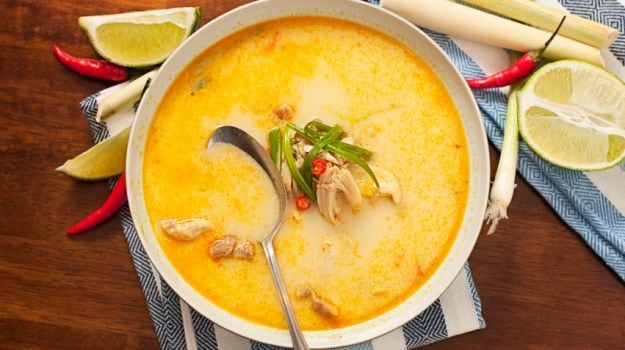
Explore the authentic Thai yellow curry with fresh vegetables with this recipe
5. Thai Soyabean In Cabage cups
For the calorie conscious vegetarian, we have a perfect balance of nutrition married to authentic Thai flavours.
6. Rocky's Pad Thai
This recipe brings to you the easiest and the simplest way to re-create the brilliance of Phad Thai wherever you are. You're just a few steps away from perfection!
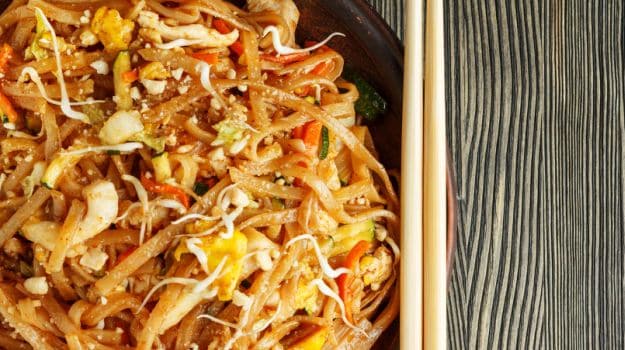
This recipe brings to you the easiest and the simplest way to re-create the brilliance of Phad Thai
7. Vegetable Thai Red Curry
A host of fresh vegetables are cooked in fiery Thai red curry paste with an added dose of coconut milk for that creamy, aromatic experience.
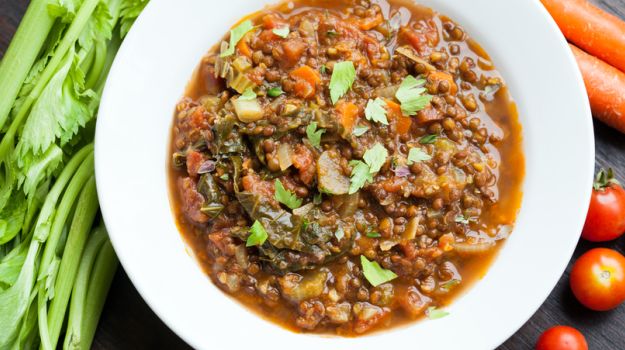
A host of fresh vegetables are cooked in fiery Thai red curry paste
8. Stir Fried Greens
Got some beans? Throw them in a pan and work them up with aromatic lemongrass, balsamic vinegar, soy sauce, olive oil, chilli paste and a finishing note of fresh cream. This will make you go Mmmm...!
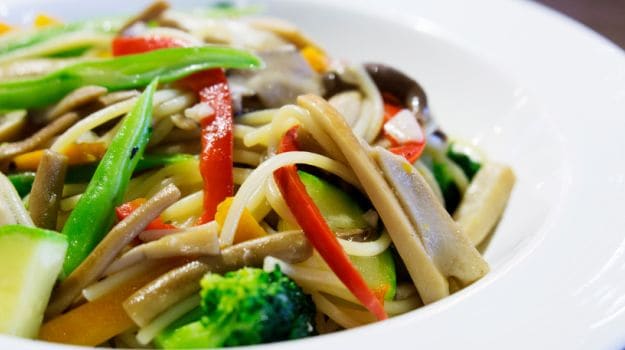
This hearty vegetable delight is as fresh and amazing as it can get
9. Battered Vegetables With Thai Sauce
A bouquet of assorted vegetables dipped in batter and deep fried to perfection. Skip the eggs and replace fish sauce with soy sauce for the ultimate veggie version.
10. Thai Chilli Broccoli Salad
Garden fresh broccoli is dressed in zingy flavours of vinaigrette, tomato puree, curd, orange juice, pomegranate and spices.
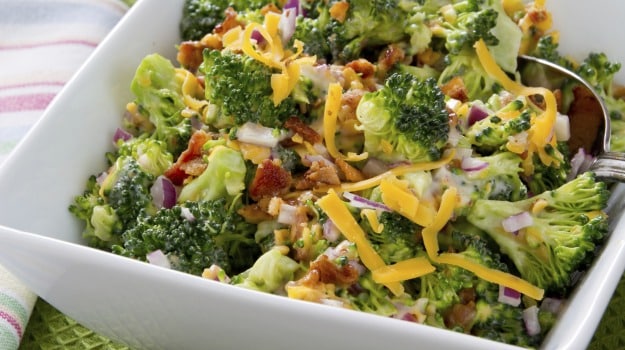
11.Thai Pomelo Salad
Summery, fresh and citrusy, this delicious salad packs the goodness of tangy pomelo, tomatoes, and scallions. The peanuts sprinkled on top adds a layer of crunch in the salad.
What are you waiting for? Don your aprons and try these amazing recipes!
Wednesday, 18 March 2020
How to Babysit a Baby: The Beginner’s Guide!

Babies are terrifying.
Ok, maybe not all the time. Often you’ll see them cooing, laughing, and playing. They look adorable and squishy. They give the impression that life itself is purely fascinating and joyful.
Until it isn’t.
When you can’t just hand the baby back to its parents, you’re on your own. Babysitting a baby is no joke.
It doesn’t have to be so stressful, though. Usually, the hardest part of caring for a baby is not knowing what to do. In this guide, I’ll help you recognize what you need to do to pull this off like a pro.
So, how do you babysit a baby? To babysit a baby, you’ll need to attend to their every need. Typically, you will be responsible for entertaining, feeding, burping, changing, and keeping the baby safe at all times, which is basically everything.
Even if you don’t have a lot of experience, you’ll be able to use the following tricks to look like you’ve been doing it for ages. This will also give you an opportunity to think about whether or not you’re up for the task. The point of this article is to make sure you’re 100%, fully, completely, and entirely prepared to babysit a baby!
Why is Babysitting a Baby Hard?
Babies are needy, and they can’t talk. A skilled mother will learn her baby’s behavior and be able to interpret and predict their needs. Even still, a new mother needs to learn how to take care of her child; it doesn’t all come naturally. So it is way harder for a babysitter.
Taking care of a baby is completely different from babysitting a toddler or small child. Their bodies function differently, and babies need way more attention. It’s not just a matter of kisses and cuddles. They are 100% dependent on you as their caregiver, and they’ll let you know when you’re not doing a good job. These things can’t actually be raised by wolves.
What are Baby’s Needs?
With babies, some things happen automatically, and some need coaxing. There is no dictating a baby’s actions, either. You’re there to serve them, regardless of what they need and how hard it is.
Essentially, there are five things that a baby will need you for: feeding, burping, changing, getting to sleep, and giving attention.
Sometimes the baby can manage one or two of these things on their own. For example, the baby might fall asleep without intervention, and burps might work their own way up. Often, though, they need help — a lot of help.
Let’s go over these needs so you can understand why babies are so...needy.
Food
This seems pretty straightforward, right? Babies need food, and they can’t feed themselves. Therefore, you must feed them.
There are some essential things to know about this, though. For example, there are a few foods and drinks that you should under no circumstances give to a baby.
Most doctors recommend that solid foods should not be given to a baby until 4 to 6 months of age. This includes soft foods like mashed bananas and other fruit. Keep in mind, though, that when you’re watching someone else’s kid, you need to play by their rules. If they don’t give the baby solids, neither should you. If the child is 6 years old and still on breastmilk, deal with it. Just do whatever the parents say.
Even when the baby is over 6 months old, there are still some foods to watch out for. For example, honey should never be given to babies under one year of age due to the risk of poisoning caused by Clostridium botulinum spores (infant botulism). However, these spores are not harmful to those over 1 year of age, since they have the ability to move them through the intestine before the toxin is made.
Here’s a quick list of examples of food and drinks along with recommendations:
- Honey (do not give under 1 year)
- Cow’s milk or any alternative milk (do not give under 1 year)
- Fruit juice (do not give under 1 year, then minimize consumption)
- Refined grains, aka white grains like in bread (do not give under 1 year)
- Candy (do not give under 1 year, then minimize consumption)
- Unpasteurized foods, including cheeses or other animal products (not recommended)
- Smoked or cured meats (not recommended)
- Allergenic foods like peanuts, eggs, wheat, strawberries, and tomatoes (do not give under 6 months)
- Fish that can contain mercury (minimize consumption)
- Chocolate (do not give under 1 year) This isn’t an exhaustive list, and some of these items are more of a problem than others. The thing to remember here is that you need to be conscious of what you give the baby.
Remember, you need to consult with the baby’s parents on this. You may wish to print out the list and ask about each item. They’re the final authority, not you.
Burping
Some babies need to burp a lot, others hardly do. It’s kind of the same thing with grownups.
A general rule of thumb is that bottle-fed babies need to burp more than breastfed babies. This is because bottle-fed babies tend to swallow more air when feeding on the bottle, as it comes out more quickly and can easily be mixed with air. Ultimately, though, every baby is different. Some can work out their burps mostly on their own, and others need help.
Changing
Babies usually don’t like poop in their diapers any more than you do. Obviously, this isn’t something that they can handle on their own. As a babysitter, you’ll have to be up for the task.
Sometimes this is straightforward and tidy; other times, it’s a downright explosion. You need to be able to handle yourself in the face of imminent danger — more on this in a bit.
Sleep
Some babies fall asleep at the drop of a hat. Other babies fight it ‘till the last minute, screaming vicious war cries until they collapse.
Never underestimate the need for a nap schedule. It’s easy to make the mistake of thinking that the baby “looks fine,” but you’ll never know until it’s too late. Just stick to the schedule and don’t question it, for everyone’s sake. For some of the best sleeping tips, I highly recommend you read our article, how to get kids to sleep while babysitting.
Attention
It shouldn’t come as a surprise that babies love the interaction. Their brains are spongy blobs of gray fat that soak up everything in their environment.
The cool thing about playing with babies is that they’ll be wiped in no time. Play hard, nap hard.
How to Tell What a Baby Needs
This is where it gets tricky. The baby starts fussing, and you need to figure out what’s wrong. Put on your Sherlock gear, super sleuth, ‘cuz here are the clues you’re looking for:
Listen to the baby before it starts to cry. Most babies will make a similar sound based on their needs. There’s actually a whole theory about this called the Dunstan Baby Language, and it’s especially effective for babies 0–3 months of age (source). Here are some examples of what to listen for before the baby actually starts crying:
- “neh,” made from a sucking motion like when a baby is nursing — the baby is hungry.
- “owh,” almost like the start of a yawn — the baby is tired.
- “heh,” discomfort — the baby might be stressed. This could come from a full diaper.
- “eairh,” a grunting or pushing sound — the baby’s gut hurts. It could have to poop, fart, or have an upset stomach. Try firmly but gently pushing the baby’s knees up to its belly one at a time like it’s riding a bicycle. It’ll help get the nasty stuff out, and the baby will smile in relief when you save the day.
- “eh,” a short sound — this is when the baby is trying to release a burp. Help the poor kid out.
This method isn’t scientifically proven, but a lot of parents swear by it. The key is to listen closely to what sounds the baby makes before crying. Once the baby is screaming at the top of its lungs,
you’re on your own.
If this doesn’t work, just run through the checks.
- Check diaper
- Play with the baby
- Try feeding the baby (might take a few tries)
- Burp the baby (patience also required)
- Do the bicycle pumps
- Hold and walk around with the baby
- Try to put the baby to sleep
If nothing seems to be working, check the baby’s temperature with a thermometer. The baby might be feeling sick.
One tip to watch out for to tell if a baby is tired:
When a baby is exhausted, it will likely flail around a bit. The same is true for toddlers. This is very different from grownups, who will usually just get sleepy and not want to do much. With babies and toddlers, you’ll see them crying and flapping their arms and legs. It kinda looks like they’re hyperactive.
If you don’t get them to bed ASAP, you’ll be in for it. The next stage is a complete meltdown, along with possible psychotic breaks and delirium.
How to Take Care of a Baby
This can be totally overwhelming, so it might be a good idea to watch the baby for a short amount of time first. Maybe keep your first couple of babysitting gigs under an hour or two until you get some experience and feel comfortable. Maybe even try visiting when the parents are home so you can have a backup in case you run into any problems.
Here are some tips to help you care for the baby’s needs:
How to Feed a Baby
If you’re feeding a baby with a bottle, you need to be patient. And if the baby is only a few months old, you’re going to need a bit of skill.
Step 1
Warm up the breastmilk or formula. You don’t want it to be hot. It should be just about body temperature. That’s the temperature it comes in naturally, after all.
That’s why you’ll see parents checking it on the inside of their wrist; it’s a sensitive area, so you can tell if it’s the right temperature. Make sure you swirl it around a bit first to distribute the warmer sections before you test it. You want it to not be cold or hot - it should feel about the same temperature as your skin. This usually takes only a few minutes.
Step 2
Sometimes the baby already knows what to do with the bottle. Often, though, you need to coax it a bit. Brush the nipple of the bottle gently back and forth across the baby’s lips. When the baby opens its mouth super wide, gently slip it in there. Sometimes you just gotta be sneaky.
Step 3
Don’t force any baby to eat if it doesn’t want to. If the baby isn’t really drinking and it keeps spitting out the bottle, then it probably isn’t hungry. Or, if after several minutes of trying to get it to latch on you are unsuccessful, admit defeat, and move on to trying something else.
It might also be that the baby is hungry, but there’s another pressing issue. The baby might refuse milk until the bigger issue is resolved, so revisit feeding attempts once the baby is calm.
How to Burp a Baby
This involves more than just patting a baby’s back. Sometimes you really need to work to get these things out, but always pat gently.
Put the baby over your shoulder really high, so that the baby’s tummy is being firmly pressed against you. This extra pressure will help work these burps out. If there’s no action after a few minutes, try a different position. Maybe something like bicycle pumps with the baby on your lap will work better. Or try putting the baby on one side and pat its back.
Keep moving the baby around and changing the position every few minutes. Getting burps out is a team effort. With some babies, the burps are really stubborn! Be patient, and keep working. Eventually, they’ll come out, and the baby will feel relieved —and so will you.
How to Change a Baby
Ok, this is one that needs a bit of practice. The easiest way is just to get someone to show you. But here are some tips to help you out:
- Get everything ready beforehand, and keep it within reach. You don’t want to be searching for wipes once the nastiness has been unleashed, and the baby is wriggling in it.
- Be gentle but firm. Babies love to move, especially when they see you making gagging faces at them. You can use moderate pressure to keep them in place.
- If it’s a boy, tuck the fire hose down. Otherwise, you’ll probably get soaked when you least expect it.
- Always wash your hands after changing a baby.
This is truly an art to master. Don’t expect it to go smoothly the first few times, unless you have a very easygoing baby. The best thing you can do is ask the parents how they put their bundle of screaming joy to sleep. But here are some tips to help you out:
Go into a dark room. Light keeps the mind active; darkness helps the brain release melatonin, which makes us sleepy.
Crank up the white noise. White noise is anything that drowns out other sounds. One trick that works great is to turn on a hairdryer to the max (on the cool setting and not in the crib!) and put the baby to sleep somewhere nearby.
Hold the baby on its side or stomach. This is often a really comfortable position for babies. Hold the baby’s head in your open hand and rock the baby side to side. If you get it just right, the baby’s head will gently sway back and forth in your hand, and it’ll be snoring gently in no time!
Subscribe to:
Comments (Atom)

